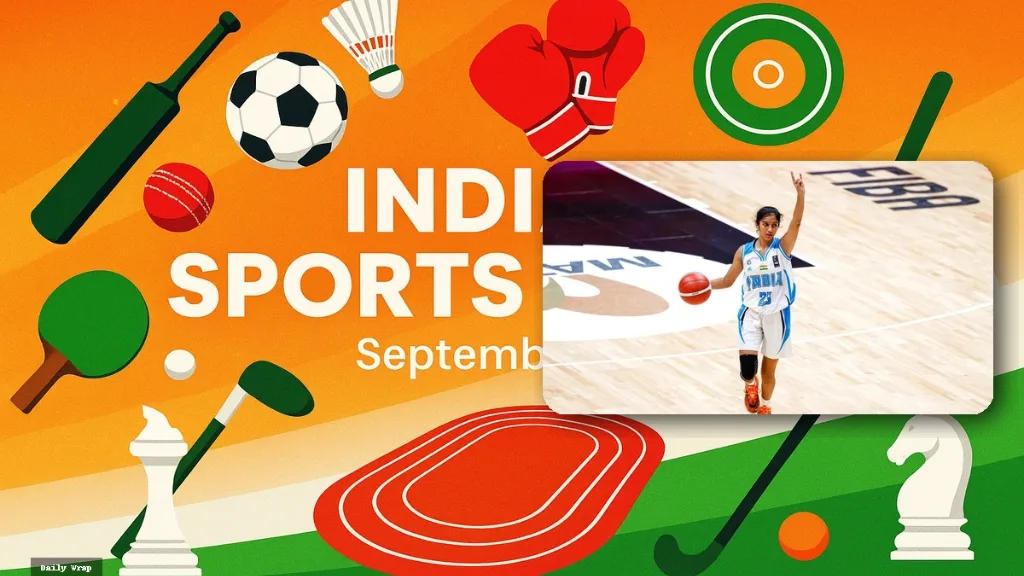Every now and then, a regular day on the calendar turns into a compact snapshot of the country’s sporting heartbeat. This Indian Sports Wrap brings together action from domestic cricket pre-season to international football qualifiers, from badminton’s relentless double shifts to boxers sharpening for the continental cycle.
The point isn’t just who won or lost—it’s what those results say about rhythm, form, selection, and the road to bigger tournaments. With federations moving camps, coaches tweaking combinations, and athletes peaking at different times, the Indian Sports Wrap helps you read the tea leaves without drowning in a flood of scorelines.
Cricket
The day began with the familiar thwack of leather on willow as state squads fine-tuned balance ahead of the domestic season. The Indian Sports Wrap notes how coaches are leaning heavily on flexible all-rounders to unlock tactical depth across formats. Openers spent long spells against the hard new ball, experimenting with trigger movements and back-foot punches. In the middle order, shot selection drills focused on tempo control rather than sheer strike-rate.
The bowling groups ran through yorker targets and wide-line variations that are becoming non-negotiable in the death overs. The big takeaway for this Indian Sports Wrap is the shift toward situational specialists who can own five to eight decisive overs in any innings, rather than relying on one big cameo.
Football
Across the country, clubs split their sessions between tactical grids and small-sided finishing exercises. Coaches hammered transitions, insisting on immediate counter-pressing after turnovers and quick diagonals to switch play. The Indian Sports Wrap emphasizes a trend that has been building quietly—attacking full-backs being instructed to vary overlaps with inverted movements to stack numbers centrally.
This opens pockets for the No. 10 and the second striker, but only works when the holding midfielder stays disciplined. Fitness departments reported clean loads, a good sign with key fixtures coming thick and fast. If you’re tracking the Indian Sports Wrap for storylines, keep an eye on set-piece routines; several teams are prioritizing near-post flick-ons that have delivered outsized returns this year.
Badminton
India’s doubles units kept their calendar humming, using the day’s sessions to drill first-three-shot aggression. The Indian Sports Wrap observed a clear emphasis on serve quality, tight returns, and early interception—three beats that define doubles momentum against top-seeded pairs. Coaches encouraged flat exchanges to neutralize height disparities and nudged pairs to gamble on mid-court pounces rather than trading safe clears.
In singles halls, volume was matched by control: athletes repeated crosscourt soft blocks and body smashes to force indecision. The Indian Sports Wrap takeaway is that the national circuit now treats net dominance as a non-negotiable platform; if you don’t own the tape, you rarely own the game.
Boxing and wrestling
In boxing centers, today’s micro-cycle blended speed ladders, rhythm pads, and short sparring bursts. The Indian Sports Wrap highlights sharper weight-cut protocols and more collaborative recovery, with nutritionists, physios, and coaches triangulating hydration, sleep, and strength. Southpaw counters were a focus, especially slip-inside lefts that break an opponent’s line.
Over on the wrestling mats, coaches revisited leg attacks with a renewed insistence on finishing cleanly at the edge. This Indian Sports Wrap notes how mat IQ—clock management, boundary awareness, and challenge reviews—often decides medal matches more than brute force.
Hockey
With the calendar pointing toward marquee events, national and domestic squads continued to refine compact, mid-block structures. The Indian Sports Wrap picked up chatter around dual-battery penalty corner routines where decoy castles create half-beats of confusion for rushers. Drag-flickers spent extra time on second-phase rebounds, while keepers trained aggressively on smothering deflections from the penalty spot.
Coaches also trialed quick 15-second restarts, understanding that a fast free hit can be the difference between a scrambled scramble and a clean circle entry. For the Indian Sports Wrap, the theme is clarity: sharpen what already works and protect the middle at all costs.
Athletics
In track and field, the day’s Indian Sports Wrap revolves around taper science. Throwers cycled through heavy-light contrasts—one heavier implement day followed by a feel-and-fast rhythm day—to hold shape without inviting fatigue. Sprinters sprinkled max-velocity fly work into otherwise controlled sessions, resisting the temptation to chase personal bests outside competition.
Jumpers chased runway consistency first, distance second. It’s a quiet form of excellence that rarely makes headlines yet defines championships. The Indian Sports Wrap lens here is simple: championship medals are born in weeks like these.
Table tennis and squash
In table tennis halls, emphasis returned to first contact quality—serves with late variations, returns brushed just enough to hide true intent, and third ball attacks that stay on the table. The Indian Sports Wrap spotlighted young paddlers who are learning to absorb pace and redirect with compact strokes, a crucial skill against European topspiners.
Squash courts echoed with ghosting drills as players rehearsed T-line recoveries. Coaches asked for earlier racquet prep and deeper lunge stability so that the second and third retrievals don’t suffer. The Indian Sports Wrap takeaway: if your feet are late, your shots are predictable.
Shooting and archery
This Indian Sports Wrap spends extra time with two precision sports where one breath can tilt a scoreboard. In shooting, athletes logged quiet hours on trigger squeeze timing and sight picture stability through micro-fatigue. Coaches kept journals on drift patterns to fine-tune sight corrections. In archery ranges, the anchor-to-release window was the star; even half-beats of tension can send arrows off-center. The Indian Sports Wrap continues to champion the mantra that process, not outcome, is the only sustainable path to medals in these sports.
Chess and cue sports
The chess circuit’s daily rhythm felt familiar but productive. Players reviewed opening novelties and paid attention to endgame tablebases, a reminder that converting small advantages is still elite currency. The Indian Sports Wrap notes a rise in practical decision-making drills—taking a good line quickly rather than hunting a perfect one. In cue rooms, athletes repeated long-pot routines with break-building patterns that reward table control. It’s the cerebral slice of the Indian Sports Wrap, where patience yields points.
Para sport excellence
A standout thread in today’s Indian Sports Wrap is the professionalization of support for para athletes. Classification reviews, bespoke strength programs, and travel plans are being locked early to cut down on stress. Coaches are aligning competition rhythm with energy budgets, ensuring athletes peak at the right meets rather than chasing every podium. It’s a timely shift that should reflect on the medal tally in the next cycle.
Grassroots and university sport
The Indian Sports Wrap always circles back to where champions first lace up—school and university fields. Inter-college leagues pushed fitness through the roof with dense schedules, though rotations are smarter now. Talent spotters, often former pros, are scanning for adaptable skill sets rather than one-dimensional brilliance. The goal is to buffer the national pipeline from over-reliance on a handful of stars. It’s the long game, and the Indian Sports Wrap salutes it.
Media, fans, and the power of small moments
There is a uniquely Indian texture to days like this—packed venues in a few cities, quiet academies in others, and a humming digital crowd that stitches them together. The Indian Sports Wrap celebrates the small wins: a youngster cracking a senior camp, a veteran finding a tweak that adds a season to their legs, a coach choosing patience over panic. When you zoom out, these are the steps that turn into rankings, records, and flags on podiums.
Editor’s notebook
The first thread is player workload across cricket and football; the calendar is unforgiving, and rotation policies will decide freshness in the decisive fortnight. The second is doubles chemistry in badminton; small improvements in serve-return sequences tend to snowball into results.
The third is penalty corner conversion in hockey; the conversion rate often mirrors tournament destiny. The Indian Sports Wrap will watch all three closely because form curves can bend quickly.
The road ahead
Momentum in sport is layered. It starts in quiet gyms and nets, turns into confident touches and clean timings, and finally becomes results under pressure. This Indian Sports Wrap closes with a reminder: the best teams and athletes are those who solve small problems early so that big stages don’t become rescue missions. With selection meetings looming and competition windows narrowing, today’s disciplined work is tomorrow’s medal shot.
FAQs
What is the Indian Sports Wrap and why should I read it daily?
The Indian Sports Wrap is a single-window recap that blends results with context. Instead of drowning in isolated updates, you get a narrative that explains what those updates mean for selections, strategy, and the weeks ahead. Reading the Indian Sports Wrap daily helps you follow arcs, not just scorelines.
Does the Indian Sports Wrap cover only mainstream sports?
No. While cricket and football get plenty of attention, the Indian Sports Wrap makes room for badminton, boxing, wrestling, hockey, athletics, shooting, archery, chess, cue sports, squash, table tennis, and para sport—because India’s medal future depends on a broader base.
How does the Indian Sports Wrap choose what to highlight?
Priority goes to competitive relevance, developmental milestones, and selection impact. If a performance moves the needle for a continental championship, world event, or key league, the Indian Sports Wrap puts it front and center.
Can I rely on the Indian Sports Wrap for selection hints?
Selection is always a coach’s call, but the Indian Sports Wrap watches patterns: training loads, role clarity, tactical experiments, and public cues. Those patterns make reasonable inferences about who is rising, who is rotating, and why.
What’s the best way to use the Indian Sports Wrap if I follow just one sport?
Even if you follow a single discipline, dipping into the Indian Sports Wrap offers perspective on recovery, scheduling, and performance cycles that cut across sports. It’s a small daily investment that pays off during big tournaments when everything suddenly matters.







